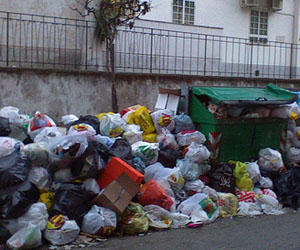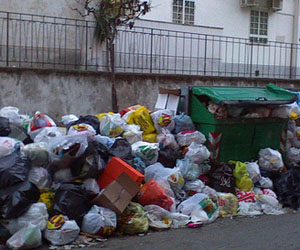
Part 3: In which our intrepid reporter concludes his trash odyssey and ends up in the dumps. Read Parts 1 and 2 here.
Step 5: In the Dumps
On the same rainy morning that Reed and I tracked my recyclables, we followed Eric Pike to his final destination, “the Pit,” where he’d deposit my trash before it was shipped off to the landfill. The Pit was hidden inside a San Francisco warehouse at the edge of town. Caterwauling seagulls were chased off by workers shooting blanks from a handgun called a “whistler,” as well as by a trained falcon, a hawk, and two dogs. Still, the rain running off the Pit’s roof was frothy white with seagull poop.
Inside, a miasma of chemicals, street-sweeper bile, and rotting burrito stung my eyes and nose. The Pit, a cement trough the size of a college gym, had been filled halfway—about nine feet deep—with compacted trash. The Big Pig opened a hatch and expelled a plasticky load coated in brown syrup. Peering down at the reeking pile, I spotted a “Have a Nice Day” sack that possibly contained my cat’s poop.
Despite San Francisco’s impressive recycling stats, a 2006 study found that more than two-thirds of the Pit’s contents could still be recycled or composted. In an effort to shame residents into achieving zero waste by 2020, this January Sunset Scavenger plastered the sides of its garbage trucks with giant photos of trash heaps. “The idea is that when you actually look at garbage,” Reed explained, “you realize that it isn’t garbage at all.”
Bidding the Pit farewell, I set off across San Francisco Bay along the same route my garbage would soon follow. A half-hour out of town, I turned down a two-lane road that wound through cattle farms before climbing a grassy hill that was taller than those around it. It was actually a 30-story mound of trash. The Altamont Landfill is owned by Sunset Scavenger’s archrival, Waste Management, the nation’s largest municipal waste collection company. Sunset Scavenger’s last effort to build its own landfill, in nearby Solano Country, was derailed 20 years ago by angry locals. It has since resigned itself to paying Waste Management to accept 1,700 tons of San Francisco’s trash each day.
Soon I was sitting in a muddy pickup along with Waste Management’s communications director, Jennifer Andrews, and the landfill’s operations manager, Neil Wise, a thick-limbed man with a graying goatee. We ascended a loamy slope of freshly buried garbage and crested near a towering fence, installed to catch blowing plastic bags. “There are times that it’s so windy out here,” Wise said, “that’s covered like a sail on a pirate ship.”
Below us was a commanding view of a misty green valley. The paved road had flattened and eroded into a soupy clay out of which protruded a rubber shoe and the odd piece of plastic. I asked Wise if the landfill was poking through its outer layer of dirt. “No, that’s litter” that blew in, he said. Litter is still litter, even on a trash heap.
Wise and I left the truck and squished across the mud to a precipice above the landfill’s “active face,” a slope of white garbage-bag moguls. I inhaled a thick bouquet: of rubber from a nearby pile of shredded car parts known as “auto fluff,” of rotting organic matter from a heap of food and yard waste called “solidification,” and of feces from sewage sludge. Each material was used as “alternative daily cover”—stuff that helps bury the landfill’s trash.
To get a better view of the active face, I scrambled atop its tipping area, the spot where 200 trucks from San Francisco and cities in the East Bay would be dumping trash—mine included—for another four days. After that, the new trash would be buried and the trucks routed to another part of the landfill. A heavy compactor rolled over the mess and gulls picked at it despite reports from a propane cannon. Wise said he wished more people would throw away paper, food, and grass instead of turning it into compost. Organic matter in landfills generate methane, a potent greenhouse gas that can also be used to generate electricity; Altamont currently captures enough methane to power 8,500 homes. (Reed dismissed Wise’s pitch for more organics as “a weak strategy to continue landfilling on the part of the nation’s biggest landfill owner.”)
Back in the truck, Wise drove over the flat top of the landfill and slithered down the other side. He stopped at a spot where each day some 9,000 gallons of leachate, the juice that seeps out of trash, flows from the mound into bacteria-filled tanks that purify it before it’s sprayed back onto the landfill for dust control. I asked if the leachate was toxic. “I don’t know how to answer that question,” Wise began slowly, “but I’ll answer it by saying they do a fish biotest on the effluent, and it passes.” But he quickly added: “I don’t think a fish would live in leachate.”
Andrews, the public relations manager, looked annoyed. “I think they would.”
“You think so?” Wise asked. “Then put it this way: I’m not gonna eat a fish that will live in leachate.”
Andrews laughed nervously. “But one of our environmental consultants said you could actually drink it and it probably wouldn’t hurt.”
“That doesn’t sound like it would go good with the pizza I had today,” Wise said.
Andrews looked relieved when Wise proclaimed that he wouldn’t let me stay at the landfill to see my trash get dumped that evening; nobody would be there to chaperone me.
By then, 10 hours into following my trash, I was exhausted. My throat was raw. My shoes were caked in sludge. And I needed a shower. But I felt like I’d returned from the wilderness having glimpsed some unseen part of myself. Perhaps this was what it meant to be a garbage man.
Step 6: The Green Machine
“I basically operate a team of glorified dumpster divers,” said Sean Davison, who was standing outside my apartment, explaining his job as Sunset Scavenger’s trash auditing manager. That he could authoritatively savage my composting skills must have been why Reed had asked him to accompany me on the final leg of my trash odyssey. Davison took one look at my compost bin’s mango skins, beet stems, and coffee grounds and proclaimed that I’d earned an A-plus. Then he noticed a fish wrapper coated in a thin film of plastic. Only wax films are allowed. “I’m not going to ding you,” he said diplomatically. “It’s hard to tell with that sort of material.”
A garbage truck soon arrived, its side plastered with a huge photo of a raspberry and the words, “Composting: A Berry Good Idea.” Paul DeMartini emerged and emptied my apartment’s green bin, which, despite my best efforts, only a couple of people in my building had been using. “That’s an easy one,” he remarked as he rolled it back inside. “Nice and light.”
We then traveled to the Organics Annex, a warehouse near the Pit. Inside, the truck’s hatch opened and the compostables slipped out onto a cement floor in a quivering pile. I nearly gagged. “It smells good,” Davison said. “It kind of smells orangey.”
Splashing across a putrid lake of garbage juice, Davison picked up a clamshell takeout container that was labeled “biodegradable.” Since 2007, when San Francisco began requiring such takeout containers to be recyclable or compostable, compost bins have swelled with them. But some companies falsely label conventional plastic as biodegradable. And even truly biodegradable corn-based plastics can cause problems if they’re sent to a regular plastics recycler. “That’s why we prefer all-paper food service ware,” he said, “because there’s no doubt it’s compostable.”
A few feet away, a dozer scraped the compost into a 12-foot heap; by day’s end it would scoop up about 400 tons of the goop—more than 10 percent of all the trash that Sunset Scavenger handles. Alfredo Hernandez, who’d been plucking contraband from the heap by hand, said the smell only bugged him when a truck dumped a particularly large load of rotting fish once a week. One day, its odor was so foul that he went straight home after work, took his clothes off in the backyard, and threw them away.
I headed east to Jepson Prairie Organics, a composting facility located in the Central Valley farming town of Vacaville. Toby Soares, the foreman, drove me to a network of diesel machines that resembled an oversize carnival ride. The raw green waste was fed into a grinder, through a trommel that separated the material by size, and then across a picking station where sorters pulled out contaminants like my plastic-lined fish wrapper.
The compost was then spread across 22 acres in 60 rows, each about 180 feet long and 6 feet high. A forklift peeled off a tarp from a row, unleashing a musty white dust. At this stage, the pile would normally be straddled by a crablike machine that would aerate it with spinning teeth, but it had been sidelined by a broken part that would cost $12,000 to replace. “Shit happens,” Soares shrugged.
Jepson has come a long way since it first pioneered food waste composting for San Francisco 12 years ago in what was the first big city program of its kind. In the early days, it stuffed the compost in plastic “Ag Bags” that generated too much moisture and essentially pickled it. When Jepson switched to exposed rows, they constantly caught on fire, until it reduced the heat inside the rows by turning them and keeping them smaller. Eight months ago, the company purchased a German-made machine that efficiently grooms the finished compost into a fine-grained loam. “This is the last stage,” Soares said as we watched the machine hum, “until the compost grows something. Then you buy that tomato over there at the store.”
Local wineries also purchase the compost to fertilize their grapes, Soares added. I recalled his words a few days later when I was at a bar, talking with an architect who’d just asked me what stories I was working on. As she daintily clutched a glass of wine, I explained that I’d been following my trash. She turned up her nose and got up to talk to someone else, unaware that she could’ve been quaffing the fruits of my rubbish. She didn’t know how lucky she was.













